
Fenland is a multi-site Special Area of Conservation in the Fens (a region in eastern England). [1] It was designated in 2005 to protect three wetland sites in Cambridgeshire with an area of 619 ha: [2]

Fenland is a multi-site Special Area of Conservation in the Fens (a region in eastern England). [1] It was designated in 2005 to protect three wetland sites in Cambridgeshire with an area of 619 ha: [2]
The SAC features two types of habitat which are protected under Annex One of the Habitats Directive: [1]
The Fens were originally a much larger wetland, but they have mainly have been drained for the benefit of agriculture and today less than 1% of the original undrained wetland habitat remains. As a remnant wetland in a modified landscape, Wicken Fen in particular needs active management to maintain water levels. Because of shrinkage of the surrounding arable land, water tends to drain out of Wicken Fen. Measures have been taken to prevent drying out, including pumping water up from a drainage channel. [3]
As is normal for SACs in Great Britain, the three sites are protected as Sites of Special Scientific Interest. The sites are also protected under the Ramsar Convention.

A fen is one of the main types of wetlands, the others being grassy marshes, forested swamps, and peaty bogs. Along with bogs, fens are a kind of mire. Fens are minerotrophic peatlands, usually fed by mineral-rich surface water or groundwater. They are characterised by their distinct water chemistry, which is pH neutral or alkaline, with relatively high dissolved mineral levels but few other plant nutrients. They are usually dominated by grasses and sedges, and typically have brown mosses. Fens frequently have a high diversity of other plant species including carnivorous plants such as Pinguicula. They may also occur along large lakes and rivers where seasonal changes in water level maintain wet soils with few woody plants. The distribution of individual species of fen plants is often closely connected to water regimes and nutrient concentrations.

The Fens, also known as the Fenlands, are a coastal plain in eastern England. This natural marshy region supported a rich ecology and numerous species, as well as absorbing storms. Most of the fens were drained several centuries ago, resulting in a flat, dry, low-lying agricultural region supported by a system of drainage channels and man-made rivers and automated pumping stations. There have been unintended consequences to this reclamation, as the land level has continued to sink and the dykes must be built higher to protect it from flooding.
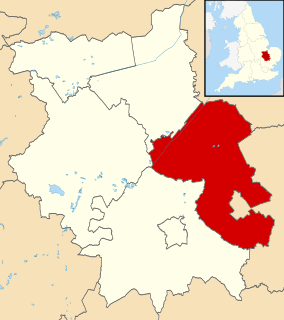
East Cambridgeshire is a local government district in Cambridgeshire, England. Its council is based in Ely. The population of the District Council at the 2011 Census was 83,818.

The Fen Rivers Way is a long distance footpath that spans a distance of 50 miles (80 km). The path runs between the City of Cambridge and the town of King's Lynn in West Norfolk. It follows the course of the River Cam and River Great Ouse across the fenland landscape into the Wash. It provides a small part of European Long Distance Path E2 which goes from Nice to Galway.
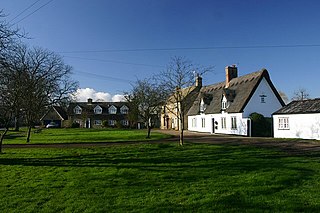
Wicken is a small village on the edge of The Fens near Soham in East Cambridgeshire, ten miles north east of Cambridge and five miles south of Ely. It is the site of Wicken Fen National Nature Reserve.
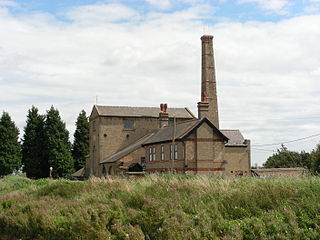
Stretham Old Engine is a steam-powered engine just south of Stretham in Cambridgeshire, England, that was used to pump water from flood-affected areas of The Fens back into the River Great Ouse. It is one of only three surviving drainage engines in East Anglia, and is a Grade II* listed building.

Wicken Fen is a 254.5 hectare biological Site of Special Scientific Interest west of Wicken in Cambridgeshire. It is also a National Nature Reserve, and a Nature Conservation Review site. It is protected by international designations as a Ramsar wetland site of international importance, and part of the Fenland Special Area of Conservation under the Habitats Directive.
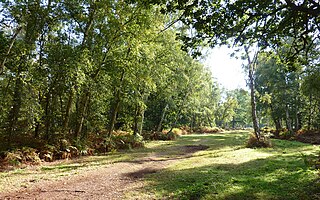
The Great Fen is a habitat restoration project being undertaken on The Fens in the county of Cambridgeshire in the United Kingdom. It is one of the largest restoration projects in the country, and aims to create a 3,700 hectare wetland and aims to connect Woodwalton Fen National Nature Reserve (NNR), Holme Fen NNR and other nature reserves to create a larger site with conservation benefits for wildlife and socio-economic benefits for people.

Holme Fen is a 269.4 hectare biological Site of Special Scientific Interest near Holme in Cambridgeshire. It is also a National Nature Reserve and a Nature Conservation Review site, Grade I. It is part of the Great Fen project, which aims to create a 3,700 wetland wildlife area including Holme Fen, Woodwalton Fen and other areas. It is home to a variety of birds, including the Eurasian siskin, Nightingale and Lesser redpoll, and around 450 species of fungi.

Upwood Meadows is a 6 hectare biological Site of Special Scientific Interest west of Upwood in Cambridgeshire. It is also a National Nature Reserve and a Grade I Nature Conservation Review site. It is managed by the Wildlife Trust for Bedfordshire, Cambridgeshire and Northamptonshire.

Roswell Pits is an 8 hectare nature reserve on the eastern outskirts of Ely in Cambridgeshire. It is managed by the Environment Agency. It is part of the Ely Pits and Meadows Site of Special Scientific Interest (SSSI)) and Geological Conservation Review site. The SSSI designation for both biological and geological interest. The site was formerly managed by the Wildlife Trust for Bedfordshire, Cambridgeshire and Northamptonshire.

Woodwalton Marsh is a 0.8 hectare biological Site of Special Scientific Interest north-east of Woodwalton in Cambridgeshire. It is managed by the Wildlife Trust for Bedfordshire, Cambridgeshire and Northamptonshire.

Whittlesea Mere was an area of open water in the Fenland area of the county of Huntingdonshire, England. The mere occupied the land southeast of Yaxley Fen, south of Farcet Fen and north of Holme Fen. The town of Whittlesey lay to the northeast.

The Cambridgeshire Lodes are a series of man-made waterways, believed to be Roman in origin, located in the county of Cambridgeshire, England. Bottisham, Swaffham Bulbeck, Reach, Burwell, Wicken and Monks Lodes all connect to the River Cam, while Soham Lode connects to the River Great Ouse. All have been navigable historically, but some are no longer officially navigable.

Potamogeton coloratus, the fen pondweed, is an aquatic plant in the genus Potamogeton. It is found in shallow peaty calcareous lakes, ponds and ditches, commonly associated with lowland fens.
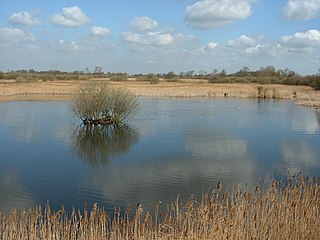
Woodwalton Fen is a 209 hectare biological Site of Special Scientific Interest west of Ramsey in Cambridgeshire. It is a Ramsar wetland site of international importance, a National Nature Reserve, a Special Area of Conservation and a Nature Conservation Review site, Grade I. The site is managed by Natural England.

L-Moor, Shepreth is a 6.6 hectare biological Site of Special Scientific Interest in Shepreth in Cambridgeshire. It is managed by the Wildlife Trust for Bedfordshire, Cambridgeshire and Northamptonshire.
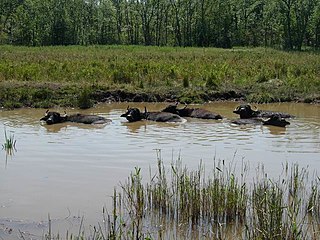
Chippenham Fen and Snailwell Poor's Fen is a 155.9 hectare biological Site of Special Scientific Interest south-east of Fordham in Cambridgeshire. It is a Nature Conservation Review site, Grade I, a Ramsar wetland site and a Special Area of Conservation. It is managed by Natural England.
| This Cambridgeshire location article is a stub. You can help Wikipedia by expanding it. |